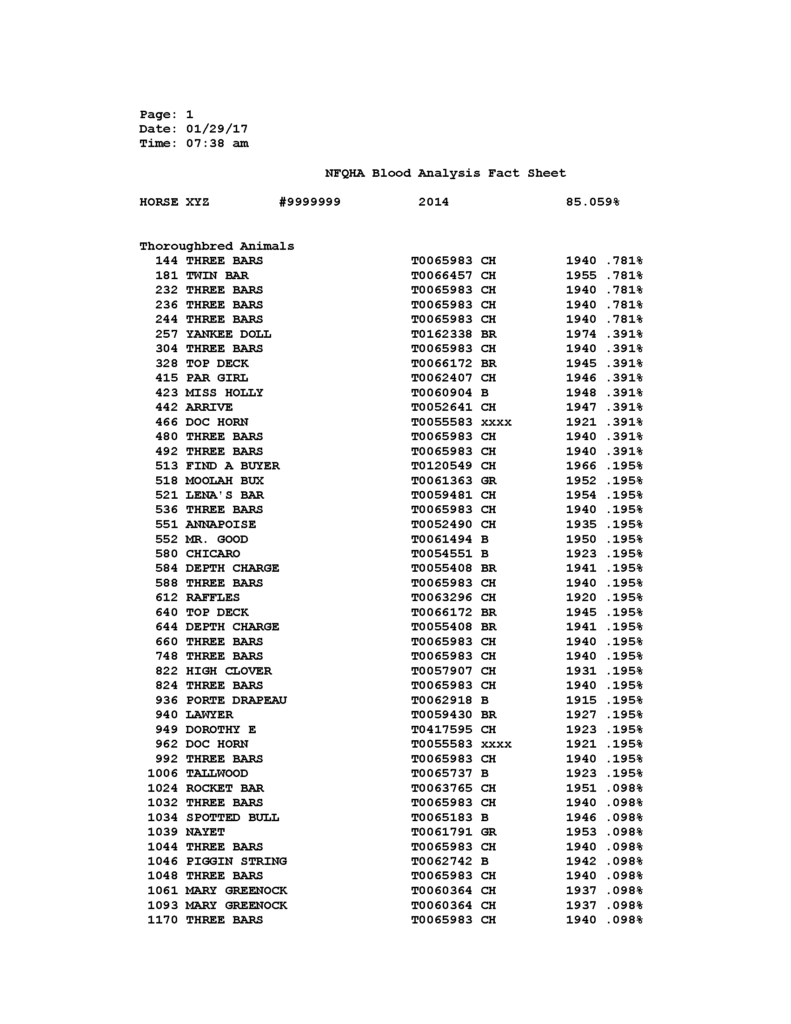Beginning 01/01/2018 – ***GRACE PERIOD extended to 04/30/2018***
All new horses submitted for research must be a minimum of 85% Quarter Horse to qualify as an NFQHA Certified Foundation Quarter Horse.
NOTE: Existing NFQHA horses and new horses submitted with an NFQHA Certified Sire & Dam are NOT effected by this change.
This change is necessitated by the fact that all Thoroughbred in the 11th generation (.098%) drops off in the 12th generation in the NFQHA research program. Each one of these TBs in the 12th generation would contribute .049% to the pedigree.
Twenty-two years ago in 1995 this seemed an insignificant amount. It takes slightly over 20 of these to equal 1%. However, due to the fact that there have been 20 generations (based on an average of 4 years per generation) added in the seventy-seven years since the inception of AQHA, it has became valid concern. In one case this year the TB in the 11th generation added up to over 3.5%, not counting any in the 12th, 13th, etc generations.
To offset the TB that is not accounted for in the 12th and older generations it has become necessary to raise the minimum qualifying percentage. It is not in the interest of the Foundation Quarter Horse breed, nor is it fair to existing certified horses, to have a young horse qualify now whose parents or grandparents would not have qualified. While it is not yet a serious problem, it is clear that it will worsen each year with new horses being born.
Why not research back further: Each additional generation doubles the amount of horses that must be accounted for, which negates the feasibility of continuing the research indefinitely. Example: the 3rd generation (grandparents) contains 4 horses, while the 4th generation contains 8 horses. Likewise the 11th generation contains 1024 horses and the 12th generation contains 2048 horses and so on. It would require running reports on all horses in at least the first 4 generations for each horse submitted and manually adding the percentages ~ which would require us to double (or more) our research fees.
Raising the minimum percentage for new horses also furthers the NFQHA 22-year-old goal of “Breeding the Quarter Horse Back into the Quarter Horse” encouraging breeders to strive to continually increase the amount of Quarter Horse blood thus ensuring the perpetuation of the Foundation Quarter Horse breed.
Please refer to the example of a Blood Analysis Fact Sheet below. It demonstrates how this NFQHA horse, and the offspring of that horse, have and will benefit by the Thoroughbred dropping off in the 11th generation.
EXAMPLE HORSE
Horse XYZ is 85.059% Foundation. The sire is 81.83% and the dam is 85.742%. Adding the sire and dam together and dividing by two dictates that XYZ should be 83.789%. This difference is a result of the TB that dropped off in the 12th generation of XYZ.
While this is definitely not the norm, it is a stark illustration of the concern of NFQHA on maintaining our Foundation Quarter Horse standards, and the Breed Type.
XYZ has 33 TBs that will drop of in his offspring. And 22 more that will drop off in their offspring.
If this TB were counted it could make a difference in whether a horse would qualify as Foundation or not depending on the other side of the pedigree. But will definitely make a difference of 1% on the Foundation percentage of the offspring.
Obviously this is not a problem for XYZ as he is easily Foundation but it could become a problem in his offspring and their descendants depending on whether they are bred to high percentage Foundation Quarter Horses.
NFQHA has always been committed to our high standards and wants to maintain those standards and realize our goal of preserving the Bulldog Foundation Quarter Horse by addressing this issue now before it becomes a problem.

